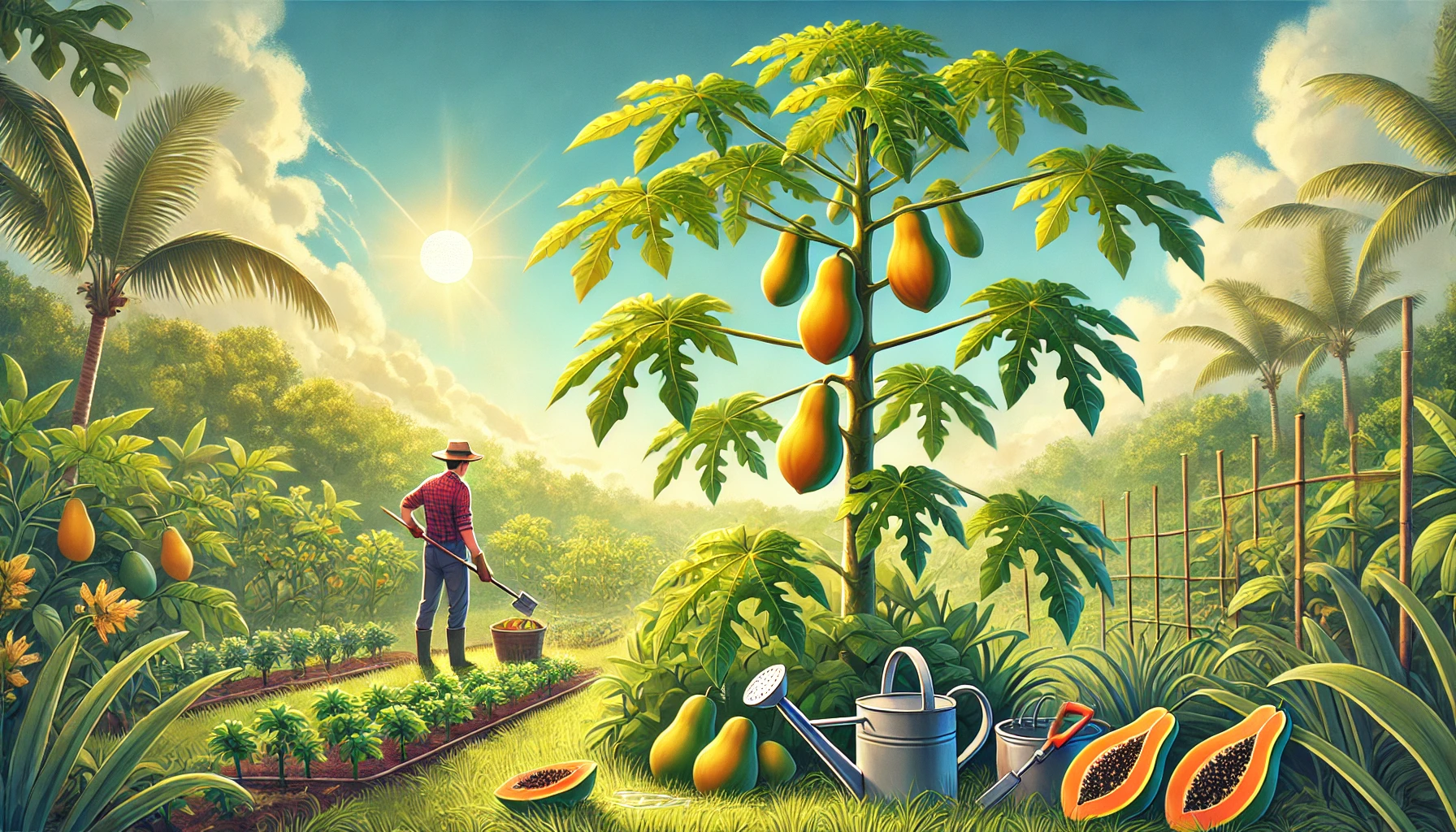1. What is papaya gardening?
Papaya gardening is the cultivation of papaya plants for their fruit.
2. Where can papayas be grown?
Papayas can be grown in tropical and subtropical regions.
3. What kind of climate do papayas prefer?
Papayas thrive in warm climates with temperatures between 70°F and 90°F.
4. Can papayas tolerate frost?
No, papayas are sensitive to frost and cannot tolerate freezing temperatures.
5. How much sunlight do papaya plants need?
Papaya plants need full sunlight for at least 6 to 8 hours a day.
6. What type of soil is best for papaya gardening?
Well-drained, fertile soil with a pH between 6 and 7 is ideal for papaya cultivation.
7. How deep should papaya seeds be planted?
Papaya seeds should be planted about ½ inch deep in the soil.
8. How often should papaya plants be watered?
Papaya plants should be watered regularly, keeping the soil consistently moist but not waterlogged.
9. What nutrients do papaya plants need?
Papaya plants need a balanced fertilizer with nitrogen, phosphorus, and potassium.
10. How tall do papaya trees grow?
Papaya trees can grow up to 20 feet tall.
11. When do papaya plants start bearing fruit?
Papaya plants typically start bearing fruit within 6 to 9 months after planting.
12. How do you pollinate papaya flowers?
Papaya flowers are typically pollinated by insects like bees.
13. How do you protect papaya plants from pests?
Papaya plants can be protected from pests by using organic pesticides or companion planting with pest-repelling plants.
14. Can papayas be grown in containers?
Yes, dwarf varieties of papaya can be grown in containers.
15. How do you prune papaya trees?
Papaya trees can be pruned to remove dead or diseased branches and to maintain shape.
16. How do you harvest papayas?
Papayas are harvested when the skin turns yellow and the fruit gives slightly to gentle pressure.
17. How long does it take for papaya fruit to ripen after harvesting?
Papaya fruit typically takes 3 to 5 days to ripen after harvesting.
18. What are some common diseases that affect papaya plants?
Common diseases that affect papaya plants include powdery mildew, black spot, and damping-off.
19. How do you control powdery mildew on papaya plants?
Powdery mildew can be controlled by improving air circulation around the plants and using fungicidal sprays.
20. How do you propagate papaya plants?
Papaya plants can be propagated by seeds or by taking stem cuttings.
21. What is the lifespan of a papaya tree?
Papaya trees typically have a lifespan of about 4 to 6 years.
22. Can papaya trees be grown indoors?
Papaya trees can be grown indoors if provided with sufficient sunlight and warmth.
23. What are the different varieties of papaya?
Common varieties of papaya include Hawaiian, Mexican, and Solo.
24. How do you transplant papaya seedlings?
Papaya seedlings should be transplanted carefully, ensuring the root ball is not disturbed.
25. How do you know if a papaya plant is male or female?
Male papaya plants have long, thin flowers, while female plants have larger, bulbous flowers.
26. How do you support papaya plants?
Papaya plants can be supported with stakes or trellises as they grow.
27. Can papaya plants tolerate salty soil?
Papaya plants are not tolerant of salty soil and may suffer from salt damage.
28. How do you prevent papaya fruit from splitting?
Papaya fruit splitting can be prevented by ensuring consistent watering and avoiding sudden changes in water availability.
29. What are the ideal temperature conditions for papaya germination?
Papaya seeds germinate best in temperatures between 70°F and 90°F.
30. How do you control weeds in a papaya garden?
Weeds can be controlled in a papaya garden by mulching and hand weeding.
31. Can papaya plants be grown from cuttings?
Yes, papaya plants can be grown from stem cuttings.
32. What is the best time of year to plant papayas?
The best time to plant papayas is during the warmer months of spring or early summer.
33. How do you protect papaya flowers from wind damage?
Papaya flowers can be protected from wind damage by providing windbreaks or staking taller plants.
34. What are the signs of overwatering papaya plants?
Signs of overwatering in papaya plants include yellowing leaves and root rot.
35. How do you control pests like aphids on papaya plants?
Pests like aphids can be controlled by spraying papaya plants with insecticidal soap or neem oil.
36. How do you improve soil drainage for papaya plants?
Soil drainage can be improved by adding organic matter like compost or sand to the soil.
37. Can papaya plants tolerate drought?
Papaya plants are not tolerant of drought and require consistent moisture.
38. How do you protect papaya plants from sunburn?
Papaya plants can be protected from sunburn by providing shade during the hottest part of the day.
39. What are some companion plants for papayas?
Companion plants for papayas include marigolds, basil, and nasturtiums, which help repel pests.
40. How do you encourage fruit production in papaya plants?
Fruit production in papaya plants can be encouraged by applying a high-phosphorus fertilizer.
41. What is the ideal spacing for planting papaya trees?
Papaya trees should be spaced about 8 to 10 feet apart to allow for proper growth.
42. Can papaya plants be grown in pots?
Yes, papaya plants can be grown in large pots with good drainage.
43. How do you prevent papaya fruit from falling prematurely?
Papaya fruit can be prevented from falling prematurely by providing adequate support to the branches and avoiding over-fertilization.
44. How do you rejuvenate an old papaya tree?
An old papaya tree can be rejuvenated by pruning away dead or diseased branches and providing additional nutrients.
45. How do you protect papaya plants from diseases like black spot?
Papaya plants can be protected from diseases like black spot by removing infected leaves and improving air circulation.
46. Can papaya plants tolerate acidic soil?
Papaya plants prefer slightly acidic soil but can tolerate a range of pH levels between 6 and 7.
47. How do you deter animals from eating papaya fruit?
Animals can be deterred from eating papaya fruit by using physical barriers like fences or netting.
48. How do you train papaya plants to grow upright?
Papaya plants can be trained to grow upright by gently staking young plants and tying them to the stakes as they grow. This helps support the plant’s weight and encourages upward growth. Regular pruning can also help maintain an upright shape.
49. How do you protect papaya plants from strong winds?
Papaya plants can be protected from strong winds by providing windbreaks such as fences or planting taller trees as a barrier.
50. How do you transplant mature papaya trees?
Mature papaya trees should be transplanted carefully, ensuring the root system is not damaged, and providing ample water and nutrients after transplanting.
51. Can dogs have papaya?
Yes, dogs can eat papaya in moderation. Papaya is a nutritious fruit that contains vitamins, minerals, and fiber that can be beneficial for dogs. However, it’s essential to remove the seeds and skin before feeding it to them, as these parts can be difficult for dogs to digest and may cause gastrointestinal issues. Also, like with any new food, introduce it gradually to see how your dog reacts and watch for any signs of allergies or digestive upset.
52. how to tell if a papaya is ripe?
You can tell if a papaya is ripe by considering its color, texture, and aroma:
- Color: A ripe papaya will typically have a yellowish-orange skin. Some papayas may have green patches even when ripe, so don’t rely solely on color.
- Texture: Gently press the surface of the papaya with your fingers. A ripe papaya should yield slightly to pressure, but it shouldn’t be too soft or mushy.
- Aroma: Ripe papayas usually have a sweet, tropical fragrance. If the papaya smells fragrant, it’s likely ripe.
If you’re unsure, you can also check the stem end of the papaya. If it gives slightly to gentle pressure and has a fruity aroma, it’s likely ripe. However, if it’s hard and has no scent, it may need more time to ripen.
53. What does papaya taste like?
The taste of papaya can be described as sweet and tropical, with a unique flavor that’s often likened to a combination of mango, peach, and citrus. Ripe papayas are sweet, juicy, and have a soft, creamy texture. Unripe papayas may be less sweet and have a firmer, more astringent taste. The flavor can vary slightly depending on the variety of papaya and its ripeness. Overall, it’s a refreshing and flavorful fruit enjoyed by many.



